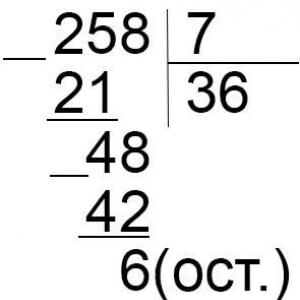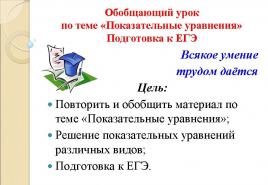12 task ege profile with logarithms. Logarithms in exams












 Back forward
Back forward
Attention! The slide preview is used for educational purposes only and may not give an idea of \u200b\u200ball the presentation features. If you are interested in this work, please download the full version.
The solution method is good if we can foresee from the very beginning - and subsequently confirm it, -
that by following this method, we will achieve the goal.
G. Leibniz
LESSON TYPE: Consolidation and improvement of knowledge.
- Didactic - Repeat and consolidate the properties of the logarithms; logarithmic equations; to fix methods for solving the largest and smallest values \u200b\u200bof a function; to improve the application of the knowledge gained in solving the problems of the Unified State Exam C1 and C3;
- Developing - The development of logical thinking, memory, cognitive interest, to continue the formation of mathematical speech and graphic culture, to develop the ability to analyze;
- Educational - To accustom to the aesthetic design of notes in notebooks, the ability to communicate, to instill accuracy.
Equipment: blackboard, computer, projector, screen, cards with test tasks, with tasks for the work of all students.
Forms of work: fronal, individual, collective.
DURING THE CLASSES
1. ORGANIZATIONAL MOMENT
2. STATEMENT OF THE GOAL
3. CHECKING THE HOME

4. ACTUALIZATION OF KNOWLEDGE
To analyze: in what tasks of the exam are logarithms found.
(B-7-simplest logarithmic equations
B-11 conversion of logarithmic expressions
B-12 - problems of physical content associated with logarithms
B-15 - finding the largest and smallest function values
C-1- trigonometric equations containing the logarithm
C-3 - a system of inequalities containing a logarithmic inequality)
At this stage, oral work is carried out, during which students not only remember the properties of the logarithms, but also perform the simplest tasks of the exam.
1) Definition of the logarithm. What do you know the properties of the logarithm? (and conditions?)
1.log b b \u003d 1
2.log b 1 \u003d 0, 3. log c (ab) \u003d log c a + log c b.
4.log c (a: b) \u003d log c a - log c b.
5.log c (b k) \u003d k * log c
2) What function is called logarithmic? D (y) -?
3) What is the decimal logarithm? ()
4) What is the natural logarithm? ()
5) What is the number e?
6) What is the derivative of? ()
7) What is the derivative of the natural logarithm?
5. ORAL WORK for all students
Calculate verbally: (tasks B-11)
| = = = = |  |
6. Independent activity of students in solving tasks
B-7 followed by verification
Solve the equations (the first two equations are spoken orally, and the rest solves the whole class independently and writes the solution in a notebook):
![]()
(While the students work on-site on their own, 3 students go to the board and work on individual cards)
After checking 3-5 equations from the spot, the guys are invited to prove that the equation has no solution (verbally)
7. Solution B-12 - (physical problems associated with logarithms)
The whole class solves the problem (at the blackboard there are 2 people: the 1st solves together with the class, the 2nd solves the same problem independently)

8. ORAL WORK (questions)
Recall the algorithm for finding the largest and smallest values \u200b\u200bof a function on a segment and on a gap.
Work on the blackboard and in the notebook.
(prototype B15 - USE)

9. Mini-test with self-control.
| № | 1 option | Option 2 |
| 1. | = | |
| 2. | ||
| 3. | ||
| 4. | ||
| 5. | ||
| 6. | Find the highest value of the function
11. Students acting as experts Children are invited to evaluate the work of the student - task C-1, performed on the examination form - 0.1.2 points (see presentation) 12. HOME The teacher explains the homework, paying attention to the fact that similar tasks were considered in the lesson. Students carefully listening to the teacher’s explanations, write down their homework. FIPI (open task bank: geometry section, 6th page) uztest.ru (logarithm conversion) C3 - task of the second part of the exam
13. SUMMING UP Today in the lesson, we repeated the properties of the logarithms; logarithmic equations; fixed methods for finding the largest and smallest values \u200b\u200bof a function; examined the problems of physical content associated with logarithms; solved the problems C1 and C3, which are offered at the exam in mathematics in the prototypes B7, B11, B12, B15, C1 and C3. Grading. |
home
How to solve the problem of the exam № 13 on exponential and logarithmic equations | 1C: Tutor
What you need to know about exponential and logarithmic equations to solve problems in the exam in mathematics?
To be able to solve exponential and logarithmic equations is very important for the successful passing of a unified state exam in mathematics of a profile level. Important for two reasons:Firstly, task No. 13 of the KIM Unified State Examination option may be infrequent, but sometimes it is just such an equation that you need to not only solve, but (similar to the task in trigonometry) choose the roots of the equation that satisfy any condition.
So, one of the options for 2017 included the following task:
a) Solve the equation 8 x – 7 . 4 x – 2 x +4 + 112 = 0.
b) Indicate the roots of this equation belonging to the segment.
Answer: a) 2; log 2 7 and b) log 2 7.In another embodiment, there was such a task:
a) Solve the equation 6log 8 2 x - 5log 8 x + 1 = 0
b) Find all the roots of this equation belonging to the segment.
Answer: a) 2 and 2√ 2 ; b) 2.There was also such:
a) Solve the equation 2log 3 2 (2cos x) - 5log 3 (2cos x) + 2 = 0.
b) Find all the roots of this equation belonging to the segment [π; 5π / 2].
Answer: and) (π / 6 + 2πk; -π / 6 + 2πk, k∊Z) and b) 11π / 6; 13π / 6.Secondly, the study of methods for solving exponential and logarithmic equations is good, because the basic mathematical methods for solving both equations and inequalities actually use the same mathematical ideas.
The basic methods for solving exponential and logarithmic equations are easy to remember, there are only five of them: reduction to the simplest equation, the use of equivalent transitions, the introduction of new unknowns, the logarithm and factorization. A separate method is the use of the properties of exponential, logarithmic and other functions in solving problems: sometimes the key to solving the equation is the domain of definition, the domain of values, non-negativity, boundedness, parity of the functions included in it.
As a rule, in Problem No. 13 there are equations that require the application of the five basic methods listed above. Each of these methods has its own characteristics that you need to know, since it is their ignorance that leads to errors in solving problems.
What are some common mistakes an examiner makes?
Often when solving equations containing an exponential-power function, students forget to consider one of the cases of equality. As you know, equations of this kind are equivalent to a combination of two systems of conditions (see below), we are talking about the case when a ( x) = 1
This error is due to the fact that when solving the equation the subject formally uses the definition of the exponential function (y \u003d ax, a\u003e 0, a ≠ 1): for and ≤ 0 exponential function really not defined
But when and = 1 defined, but not indicative, since the unit in any real degree is identically equal to itself. So if in the equation under consideration for and(x) = 1 If the correct numerical equality occurs, then the corresponding values \u200b\u200bof the variable will be the roots of the equation.
Another mistake is to use the properties of logarithms without taking into account the range of permissible values. For example, the property “the logarithm of a product is equal to the sum of logarithms”, which is well known to many people, turns out to have a generalization:
log a ( f(x)g(x)) \u003d log a │ f(x) │ + log a │g ( x) │, for f(x)g(x) > 0, a > 0, a ≠ 1Indeed, for the expression on the left side of this equality to be defined, it is enough that the product of functions f and g was positive, but the functions themselves can be both greater and less than zero at the same time, therefore, when applying this property, it is necessary to use the concept of a module.
And there are many such examples. Therefore, for the effective development of methods for solving exponential and logarithmic equations, it is best to use the services that will be able to talk about such "pitfalls" on examples of solving the corresponding examination problems.
Exercise regularly in problem solving
To start practicing on the portal "1C: Tutor", enough.
You can:All courses consist of a methodically correct sequence of theory and practice, necessary for the successful solution of problems. They include theory in the form of texts, slides and videos, problems with solutions, interactive simulators, models, and tests.
Still have questions? Give us a call 8 800 551-50-78 or write to online chat.
Here are key phrases to make search engines better find our tips:
How to solve task 13 in the Unified State Exam exam, problems on logarithms, Kim Unified State Exam 2017, preparation for Unified State Examination, mathematics profile, Mathematics profile, solving equations and logarithms, solving problems on exponential Unified State Examination equations, calculating the properties of logarithms, exponential function, problems in specialized mathematics level, the application of the properties of logarithms, solving problems to the roots, the tasks of the Unified State Exam 2017 according to exponential equations, preparation for the exams of 11th grade graduates in 2018, entering a technical university.
In the task №12 USE in mathematics of the profile level, we need to find the largest or smallest value of the function. For this, it is necessary to use, obviously, the derivative. Let's look at a typical example.
Analysis of typical options for tasks No. 12 USE in mathematics of a profile level
The first version of the assignment (demo version 2018)
Find the maximum point of the function y \u003d ln (x + 4) 2 + 2x + 7.
Solution Algorithm:
- We find the derivative.
- We write down the answer.
Decision:
1. We are looking for the values \u200b\u200bof x for which the logarithm makes sense. To do this, solve the inequality:
Because the square of any number is non-negative. The solution to the inequality is only the value of x for which x + 4 ≠ 0, i.e. at x ≠ -4.
2. We find the derivative:
’\u003d (ln (x + 4) 2 + 2x + 7)’
By the property of the logarithm we get:
’\u003d (ln (x + 4) 2)’ + (2x) ’+ (7)’.
According to the formula of the derivative of a complex function:
(lnf) ’\u003d (1 / f) ∙ f’. We have f \u003d (x + 4) 2
y, \u003d (ln (x + 4) 2) '+ 2 + 0 \u003d (1 / (x + 4) 2) ∙ ((x + 4) 2)' + 2 \u003d (1 / (x + 4) 2 2) ∙ (x 2 + 8x + 16) '+ 2 \u003d 2 (x + 4) / ((x + 4) 2) + 2
y ’\u003d 2 / (x + 4) + 2
3. Equate the derivative to zero:
y, \u003d 0 → (2 + 2 ∙ (x + 4)) / (x + 4) \u003d 0,
2 + 2x +8 \u003d 0, 2x + 10 \u003d 0,
The second version of the task (from Yashchenko, No. 1)
Find the minimum point of the function y \u003d x - ln (x + 6) + 3.
Solution Algorithm:
- Define the scope of the function.
- We find the derivative.
- We determine at which points the derivative is 0.
- We exclude points that do not belong to the domain of definition.
- Among the remaining points, we look for the values \u200b\u200bof x at which the function has a minimum.
- We write down the answer.
Decision:
1. DLD:.
2. Find the derivative of the function:
![]()
3. Equate the resulting expression to zero:
4. We got one point x \u003d -5 belonging to the domain of definition of the function.
5. At this point, the function has an extremum. Check if this is the minimum. When x \u003d -4
![]()
For x \u003d -5.5, the derivative of the function is negative, since
![]()
Therefore, the point x \u003d -5 is the minimum point.
The third version of the task (from Yashchenko, No. 12)
Solution Algorithm :.
- We find the derivative.
- We determine at which points the derivative is 0.
- We exclude points that do not belong to the given segment.
- Among the remaining points, we look for the values \u200b\u200bof x at which the function has a maximum.
- We find the values \u200b\u200bof the function at the ends of the segment.
- We are looking for the largest among the obtained values.
- We write down the answer.
Decision:
1. We calculate the derivative of the function, we obtain
![]()


F(x).png)






